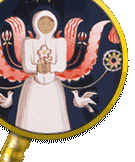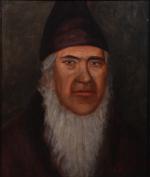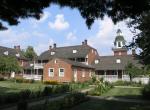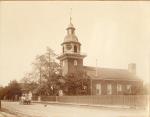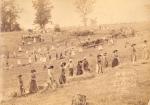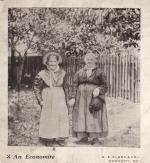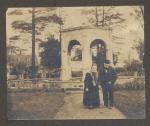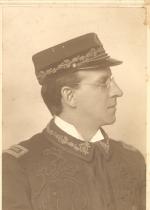Chapter Three: The Harmony Society
Religious splits among Christians during the Protestant Reformation caused violent upheavals and devastating wars that remade the map of Europe. For centuries afterwards, the Roman Catholic and established Protestant churches feared religious separatists, that is, individuals who invoked the principle of personal faith and refused to respect established religious authorities, for they threatened the stability of both church and state. Yet since the time of John Hus's heretical views in the early fifteenth century, the German states had remained hotbeds of religious fervor and dissent.
In the late 1700s, a new separatist movement appeared in the town of Wurttemberg in southern Germany. There a young farmer and weaver by the name of Johann George Rapp stopped attending Lutheran services and began to preach to his neighbors. Called before the Church Council in April 1785, Rapp explained that he had found a better light - the fount and body of Christ - and had since found himself "weakened rather than strengthened" in the local church.
In the days that followed, Rapp and his followers baptized their children within their own fellowship and refused to send them to the local schools, refused to swear oaths, worked on the customary Sabbath, and insisted that God had forbidden them to attend Lutheran church services. Rapp declared that he no longer considered the local pastor a servant of God and that Lutheran ministers could no longer forgive sins.
Fines, imprisonment, and threats of exile had no effect on this renegade evangelist or his growing body of congregants. Ordered to be silent at a formal hearing in 1791, Rapp replied "I am a prophet and am called to be one!" Eight years later Rapp drew up articles of faith that included a refusal to train for military service because "those who possess the inner peace of God do not like to hurt creatures, and accordingly they may bear no weapons of war."
By 1803, Rapp had boldly declared himself the bishop of a separatist evangelical movement that was spreading through neighboring towns. Fearing the crackdown that was sure to follow, in that year Rapp sailed to Pennsylvania to find a new home for his flock, where they could prepare in peace for the Second Coming of Christ and "end of days" that Rapp believed was imminent. After an initial scouting trip, Rapp wrote back to Germany that he was sure "God has prepared a little place for us" in a land where "they want you to think and believe what you wish."
Responding to his call, more than 500 followers sold all their possessions and booked passage to the New World. On a sunny July morning in 1804, three hundred Lutheran separatists from Wurttemberg, Germany, disembarked at the port of Baltimore after a long, arduous journey. Soon joined by another 260 who had arrived at the port of Philadelphia, the immigrants made their way to western Pennsylvania, where they proceeded to clear the wilderness and build a "community of equality" where members held all goods and property in common. They called their new home Harmony.
Harmony.
Here they lived and worshipped for ten years while waiting for the Second Coming of Christ. Rapp held that Jesus taught and commanded a community of goods. In 1805 the Harmonists signed Articles of Association by which they granted all property to Rapp and his associates, who in turn agreed to provide them with "all the necessities of life." Two years later the faithful of Harmony embraced celibacy so that they might be better prepared for the end of days. They buried those who died in the Harmony Society Cemetery without headstones, or even mounds to distinguish graves, so that none could take precedence over another.
Harmony Society Cemetery without headstones, or even mounds to distinguish graves, so that none could take precedence over another.
Rapp also believed in hard work and self-sufficiency. The "Rappites" or "Harmonists" as they were called, cleared and planted productive fields, built grist and sawmills, and started a variety of economic enterprises. But Harmony's long distance - twelve miles - from navigable waters, and the inadequacy of the soil for vineyards left the Rappites dissatisfied.
By 1814 Rapp had decided that the community should relocate to the banks of the Wabash River in the Indiana Territory. There they established a new village of Harmony, larger, more productive, and more prosperous than the first. Harmony quickly became an important business center, but the Rappites were dissatisfied with its isolation, and its swampy waters and stinging insects brought illness and death. In 1824 they sold the property to English industrialist Robert Owen and returned to Pennsylvania.
This time they settled in a beautiful valley on the Ohio River, with hills on either side to protect them from cold winter winds, and good transportation by stage and river to the outside world. Here, in a town they named Economy, the Rappites constructed a religiously based, communal economic and social system that attracted international attention.
Economy, the Rappites constructed a religiously based, communal economic and social system that attracted international attention.
Oversight of the community was divided between Rapp, who attended to members' spiritual lives, and his adopted son, Frederick Reichart Rapp, who ran the Association's business and temporal affairs until his death in 1834, when he was succeeded first by Jacob Henrici and then by Jonathan Lenz. Agriculture always lay at the center of the Rappites' world, but to insure their self-sufficiency, the community embraced the latest labor-saving machinery for the manufacture of their clothing, food, drink -even the repair of watches and clocks.
Economy soon became a manufacturing center with its own woolen and cotton mills, a gristmill, sawmill, and distillery. They built a centralized steam laundry and dairy and developed an award-winning silk industry. By the 1850s their communal economic system had generated more than a million dollars in assets, which the Harmonists invested in coal mines, sawmills, oil wells, railroads, and factories. In the 1870s Rappite enterprises employed hundreds of workers in western Pennsylvania, including more than two hundred Chinese at their cutlery manufacturing factory at Beaver Falls.
The Rappites began to attract visitors in the early 1820s. Indeed, by that time their reputation was so widespread that George Gordon Lord Byron satirized them in his epic poem, Don Juan. In the decades that followed, visitors from around the world made the trip to Economy to understand the communitarian principles that had created such economic success and social harmony. For in the rough and tumble world of nineteenth-century America, the town of Economy appeared an oasis of peace, stability, and order. As the scholar Charles Nordhoff observed in the 1870s, "Neatness and a Sunday quiet are the prevailing characteristics in Economy."
Upon approaching the community, visitors first noticed large, well-tended fields and orchards. Economy itself was a town of about 120 brick and frame houses that lined broad, tree-shaded streets with brick footpaths and clean public benches. The Rappites devoted great attention to gardening. Water from a reservoir in the surrounding hills flowed into troughs on each street, from which residents watered the gardens surrounding their homes and the grapevines growing between first and second floor windows. Visitors were also struck by the Rappites' German attire, the men dressed in short, light-blue jackets and tall, broad-brimmed hats; the women in plain dresses and Norman caps-all made from silk and fiber grown, reeled, spun, woven, and sewn together within the community.
Upon Frederick Rapp's death in 1834, "Father" Rapp also took over the temporal affairs of Economy and was widely regarded as a practical, good-natured, active, and deeply spiritual leader. Each Sunday, sitting at a table on a platform in the sturdy brick Harmony Society Church, he preached a gospel of humility, simplicity, industriousness, self-sacrifice, prayer, and self-examination. Rapp held onto his belief in Christ's Second Coming to the end. On his death bed the ninety-year-old patriarch was reported to have said, "If I did not know that the dear Lord meant I should present you all to him, I should think my last moments come."
Harmony Society Church, he preached a gospel of humility, simplicity, industriousness, self-sacrifice, prayer, and self-examination. Rapp held onto his belief in Christ's Second Coming to the end. On his death bed the ninety-year-old patriarch was reported to have said, "If I did not know that the dear Lord meant I should present you all to him, I should think my last moments come."
After Rapp's death in 1847, Economy continued to prosper. Wealth, however, did not ensure the survival of the Harmonist community. As the original German settlers grew older, they failed to attract new members, and indeed, had little desire to do so since their chief aim was to prepare themselves for the return of Christ and their ascension to Heaven. When questioned about what would become of their town and financial holdings, they would reply, "The Lord will show us a way."
The aging Rappites did, however, employ outsiders as laborers and educated their children, some of whom they adopted within their community. And it was one of these children, John Duss, who oversaw the final dissolution of the Harmonists' holy community. By the early 1890s the seven remaining Harmonists were preparing for death and the community was losing money rapidly due to poor investments and debt on its industries. Duss bought the Society a few extra years by selling off property and liquidating assets, but then made questionable use of funds to finance his own musical career.
In 1905, while Duss was away on tour, his wife Susie convinced the two remaining trustees to dissolve the Society, then placed all of its assets in her own name. When Pennsylvania state officials mounted a legal challenge to the Dusses' legally questionable grab of the now defunct community's assets, a nasty eleven-year court battle ensued.
When it was over, the Pennsylvania Supreme Court divided what remained of the Harmony Society estate between the Dusses and the Commonwealth, which used its share to purchase six acres of Economy and set up the Old Economy Memorial, an historic district of seventeen original Harmonist buildings now operated by the Pennsylvania Historical and Museum Commission.
Old Economy Memorial, an historic district of seventeen original Harmonist buildings now operated by the Pennsylvania Historical and Museum Commission.
In the late 1700s, a new separatist movement appeared in the town of Wurttemberg in southern Germany. There a young farmer and weaver by the name of Johann George Rapp stopped attending Lutheran services and began to preach to his neighbors. Called before the Church Council in April 1785, Rapp explained that he had found a better light - the fount and body of Christ - and had since found himself "weakened rather than strengthened" in the local church.
In the days that followed, Rapp and his followers baptized their children within their own fellowship and refused to send them to the local schools, refused to swear oaths, worked on the customary Sabbath, and insisted that God had forbidden them to attend Lutheran church services. Rapp declared that he no longer considered the local pastor a servant of God and that Lutheran ministers could no longer forgive sins.
Fines, imprisonment, and threats of exile had no effect on this renegade evangelist or his growing body of congregants. Ordered to be silent at a formal hearing in 1791, Rapp replied "I am a prophet and am called to be one!" Eight years later Rapp drew up articles of faith that included a refusal to train for military service because "those who possess the inner peace of God do not like to hurt creatures, and accordingly they may bear no weapons of war."
By 1803, Rapp had boldly declared himself the bishop of a separatist evangelical movement that was spreading through neighboring towns. Fearing the crackdown that was sure to follow, in that year Rapp sailed to Pennsylvania to find a new home for his flock, where they could prepare in peace for the Second Coming of Christ and "end of days" that Rapp believed was imminent. After an initial scouting trip, Rapp wrote back to Germany that he was sure "God has prepared a little place for us" in a land where "they want you to think and believe what you wish."
Responding to his call, more than 500 followers sold all their possessions and booked passage to the New World. On a sunny July morning in 1804, three hundred Lutheran separatists from Wurttemberg, Germany, disembarked at the port of Baltimore after a long, arduous journey. Soon joined by another 260 who had arrived at the port of Philadelphia, the immigrants made their way to western Pennsylvania, where they proceeded to clear the wilderness and build a "community of equality" where members held all goods and property in common. They called their new home
Here they lived and worshipped for ten years while waiting for the Second Coming of Christ. Rapp held that Jesus taught and commanded a community of goods. In 1805 the Harmonists signed Articles of Association by which they granted all property to Rapp and his associates, who in turn agreed to provide them with "all the necessities of life." Two years later the faithful of Harmony embraced celibacy so that they might be better prepared for the end of days. They buried those who died in the
Rapp also believed in hard work and self-sufficiency. The "Rappites" or "Harmonists" as they were called, cleared and planted productive fields, built grist and sawmills, and started a variety of economic enterprises. But Harmony's long distance - twelve miles - from navigable waters, and the inadequacy of the soil for vineyards left the Rappites dissatisfied.
By 1814 Rapp had decided that the community should relocate to the banks of the Wabash River in the Indiana Territory. There they established a new village of Harmony, larger, more productive, and more prosperous than the first. Harmony quickly became an important business center, but the Rappites were dissatisfied with its isolation, and its swampy waters and stinging insects brought illness and death. In 1824 they sold the property to English industrialist Robert Owen and returned to Pennsylvania.
This time they settled in a beautiful valley on the Ohio River, with hills on either side to protect them from cold winter winds, and good transportation by stage and river to the outside world. Here, in a town they named
Oversight of the community was divided between Rapp, who attended to members' spiritual lives, and his adopted son, Frederick Reichart Rapp, who ran the Association's business and temporal affairs until his death in 1834, when he was succeeded first by Jacob Henrici and then by Jonathan Lenz. Agriculture always lay at the center of the Rappites' world, but to insure their self-sufficiency, the community embraced the latest labor-saving machinery for the manufacture of their clothing, food, drink -even the repair of watches and clocks.
Economy soon became a manufacturing center with its own woolen and cotton mills, a gristmill, sawmill, and distillery. They built a centralized steam laundry and dairy and developed an award-winning silk industry. By the 1850s their communal economic system had generated more than a million dollars in assets, which the Harmonists invested in coal mines, sawmills, oil wells, railroads, and factories. In the 1870s Rappite enterprises employed hundreds of workers in western Pennsylvania, including more than two hundred Chinese at their cutlery manufacturing factory at Beaver Falls.
The Rappites began to attract visitors in the early 1820s. Indeed, by that time their reputation was so widespread that George Gordon Lord Byron satirized them in his epic poem, Don Juan. In the decades that followed, visitors from around the world made the trip to Economy to understand the communitarian principles that had created such economic success and social harmony. For in the rough and tumble world of nineteenth-century America, the town of Economy appeared an oasis of peace, stability, and order. As the scholar Charles Nordhoff observed in the 1870s, "Neatness and a Sunday quiet are the prevailing characteristics in Economy."
Upon approaching the community, visitors first noticed large, well-tended fields and orchards. Economy itself was a town of about 120 brick and frame houses that lined broad, tree-shaded streets with brick footpaths and clean public benches. The Rappites devoted great attention to gardening. Water from a reservoir in the surrounding hills flowed into troughs on each street, from which residents watered the gardens surrounding their homes and the grapevines growing between first and second floor windows. Visitors were also struck by the Rappites' German attire, the men dressed in short, light-blue jackets and tall, broad-brimmed hats; the women in plain dresses and Norman caps-all made from silk and fiber grown, reeled, spun, woven, and sewn together within the community.
Upon Frederick Rapp's death in 1834, "Father" Rapp also took over the temporal affairs of Economy and was widely regarded as a practical, good-natured, active, and deeply spiritual leader. Each Sunday, sitting at a table on a platform in the sturdy brick
After Rapp's death in 1847, Economy continued to prosper. Wealth, however, did not ensure the survival of the Harmonist community. As the original German settlers grew older, they failed to attract new members, and indeed, had little desire to do so since their chief aim was to prepare themselves for the return of Christ and their ascension to Heaven. When questioned about what would become of their town and financial holdings, they would reply, "The Lord will show us a way."
The aging Rappites did, however, employ outsiders as laborers and educated their children, some of whom they adopted within their community. And it was one of these children, John Duss, who oversaw the final dissolution of the Harmonists' holy community. By the early 1890s the seven remaining Harmonists were preparing for death and the community was losing money rapidly due to poor investments and debt on its industries. Duss bought the Society a few extra years by selling off property and liquidating assets, but then made questionable use of funds to finance his own musical career.
In 1905, while Duss was away on tour, his wife Susie convinced the two remaining trustees to dissolve the Society, then placed all of its assets in her own name. When Pennsylvania state officials mounted a legal challenge to the Dusses' legally questionable grab of the now defunct community's assets, a nasty eleven-year court battle ensued.
When it was over, the Pennsylvania Supreme Court divided what remained of the Harmony Society estate between the Dusses and the Commonwealth, which used its share to purchase six acres of Economy and set up the


